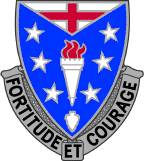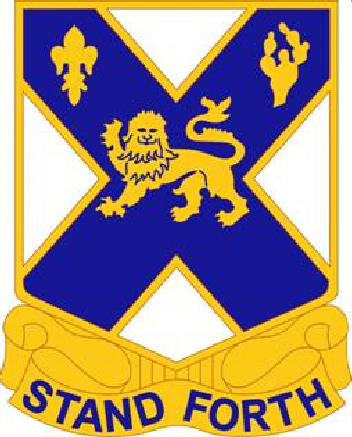|
103rd Infantry Regiment (United States)
The 103rd Infantry Regiment was an infantry regiment of the United States Army that served in combat in the American Civil War, World War I, and World War II. It was an Army National Guard regiment from the states making up New England, but most of its soldiers came from Maine. It was a part of the 26th Infantry Division and the 43rd Infantry Division. During the Cold War, the regiment was converted into an armored regiment, and its lineage is presently perpetuated by an engineer battalion in the Maine Army National Guard. History American Civil War The 103rd Infantry Regiment was originally formed in 1861 as the 2nd Maine Volunteer Infantry Regiment. It served in the Union Army and was one of the first US regiments to see combat against the Confederates. It served in the First Battle of Bull Run, which was the first major battle of the Civil War and a decisive Union defeat. However, the 2nd Maine was one of the last regiments to retreat from the field. It served in the ... [...More Info...] [...Related Items...] OR: [Wikipedia] [Google] [Baidu] |
New England
New England is a region consisting of six states in the Northeastern United States: Connecticut, Maine, Massachusetts, New Hampshire, Rhode Island, and Vermont. It is bordered by the state of New York (state), New York to the west and by the Canadian provinces of New Brunswick to the northeast and Quebec to the north. The Gulf of Maine and Atlantic Ocean are to the east and southeast, and Long Island Sound is to the southwest. Boston is New England's largest city and the capital of Massachusetts. Greater Boston, comprising the Boston–Worcester–Providence Combined Statistical Area, houses more than half of New England's population; this area includes Worcester, Massachusetts, the second-largest city in New England; Manchester, New Hampshire, the largest city in New Hampshire; and Providence, Rhode Island, the capital of and largest city in Rhode Island. In 1620, the Pilgrims (Plymouth Colony), Pilgrims established Plymouth Colony, the second successful settlement in Briti ... [...More Info...] [...Related Items...] OR: [Wikipedia] [Google] [Baidu] |
United States Army
The United States Army (USA) is the primary Land warfare, land service branch of the United States Department of Defense. It is designated as the Army of the United States in the United States Constitution.Article II, section 2, clause 1 of the United States Constitution (1789).See alsTitle 10, Subtitle B, Chapter 301, Section 3001 It operates under the authority, direction, and control of the United States Secretary of Defense, United States secretary of defense. It is one of the six armed forces and one of the eight uniformed services of the United States. The Army is the most senior branch in order of precedence amongst the armed services. It has its roots in the Continental Army, formed on 14 June 1775 to fight against the British for independence during the American Revolutionary War (1775–1783). After the Revolutionary War, the Congress of the Confederation created the United States Army on 3 June 1784 to replace the disbanded Continental Army.Library of CongressJournals ... [...More Info...] [...Related Items...] OR: [Wikipedia] [Google] [Baidu] |
104th Infantry Regiment (United States)
The 104th Infantry Regiment traces its history to 14 November 1639, when it was first mustered as the Springfield Train Band in Springfield, Massachusetts. In 1662 the unit was formed into the Hampshire Regiment of the Massachusetts Militia. It later served in the Continental Army during the American Revolution, with Union forces in the American Civil War, and as a federalized Massachusetts National Guard regiment with the U.S. Army during Spanish–American War, Mexican Border Campaign, World War I and World War II. In 2005, the last active element of the regiment, the 1st Battalion, was inactivated and consolidated with the 1st Battalion, 181st Infantry Regiment. Heraldic items Coat of arms *Blazon: **Shield: Per chevron and enhanced Argent and Azure, in chief a cross Gules, between six mullets pilewise a crenelated torch of the first flamant of three of the third, and in base an Indian arrowhead point to base of the first. **Crest: That for the regiments of the Massachus ... [...More Info...] [...Related Items...] OR: [Wikipedia] [Google] [Baidu] |
102nd Infantry Regiment (United States)
The 102nd Infantry Regiment currently consists of one battalion in the Connecticut National Guard. In the modern U.S. Army regimental system, regimental designation is used only in historical tradition, and there is no regimental headquarters or staff. It is one of several National Guard units with colonial roots. The 1st Battalion, 102nd Regiment is headquartered in New Haven, Connecticut. Its mascot is Sergeant Stubby. Service history World War I In August 1917, the Regiment was organized with 3,755 officers and enlisted men: * Headquarters & Headquarters Company- 303 ** Supply Company- 140 ** Machine Gun Company- 178 ** Medical & Chaplain Detachment- 56 * Infantry Battalion (x3)- 1,026 ** Headquarters- 2 ** Rifle Company (x4)- 256 The 102nd was stationed at the Neufchateau, Vosges Training Area during the fall and winter of 1917 with the 26th Division also known as the "Yankee Division" which included the 101st, 103rd and 104th infantry regiments. They were then deplo ... [...More Info...] [...Related Items...] OR: [Wikipedia] [Google] [Baidu] |
133 Eng Bn DUI , also known as the Fiat 133 and Nasr 133, a city car
{{numberdis ...
133 may refer to: *133 (number) *AD 133 *133 BC *133 (song) *133 (New Jersey bus) *133 Cyrene, a main-belt asteroid *SEAT 133 The SEAT 133 is a small rear-engined car designed and sold by SEAT in Spain from 1974 until 1979, and until 1982 to export markets. The car used the chassis and engine of the by then defunct Fiat 850, Fiat/SEAT 850 and featured a new body in the st ... [...More Info...] [...Related Items...] OR: [Wikipedia] [Google] [Baidu] |
Charles W
The F/V ''Charles W'', also known as Annie J Larsen, is a historic fishing schooner anchored in Petersburg, Alaska. At the time of its retirement in 2000, it was the oldest fishing vessel in the fishing fleet of Southeast Alaska, and the only known wooden fishing vessel in the entire state still in active service. Launched in 1907, she was first used in the halibut fisheries of Puget Sound and the Bering Sea as the ''Annie J Larsen''. In 1925 she was purchased by the Alaska Glacier Seafood Company, refitted for shrimp trawling, and renamed ''Charles W'' in honor of owner Karl Sifferman's father. The company was one of the pioneers of the local shrimp fishery, a business it began to phase out due to increasing competition in the 1970s. The ''Charles W'' was the last of the company's fleet of ships, which numbered twelve at its height. The boat was acquired in 2002 by the nonprofit Friends of the ''Charles W''. The boat was listed on the National Register of Historic Place ... [...More Info...] [...Related Items...] OR: [Wikipedia] [Google] [Baidu] |
Charles Davis Jameson
Charles Davis Jameson (February 24, 1827 – November 6, 1862) was an American Civil War general and Democratic Party candidate for Governor of Maine. He contracted "camp fever" (typhoid) at the Battle of Fair Oaks, returned to his native state of Maine, dying in transit or soon after. Jameson was born in Gorham, Maine, but his family moved to the lumbering and sawmilling center of Old Town, Maine, when he was still a child. Jameson became a successful lumberman, and in 1860 was a delegate to the Democratic National Convention from Maine. With the outbreak of war in 1861 he was elected Colonel commanding the 2nd Maine Volunteer Infantry Regiment, the first Maine unit to leave the state for the front. He led his regiment into the First Battle of Bull Run and was soon made Brigadier General of Volunteers. In the months after Bull Run the Democratic Party of Maine split into anti-war and pro-war factions, and Jameson became the gubernatorial candidate of the "War Democrats ... [...More Info...] [...Related Items...] OR: [Wikipedia] [Google] [Baidu] |
Battle Of Luzon
The Battle of Luzon (; ; ) was a land battle of the Pacific Theater of Operations of World War II by the Allied forces of the U.S., its colony the Philippines, Mexico, and allies against forces of the Empire of Japan. The battle resulted in a U.S. and Filipino victory. The Allies had taken control of all strategically and economically important locations of Luzon by March 1945, although pockets of Japanese resistance held out in the mountains until the unconditional surrender of Japan. While not the highest in U.S. casualties, it is the highest net casualty battle U.S. forces fought in World War II, with 192,000 to 217,000 Japanese combatants dead (mostly from starvation and disease), 8,000 American combatants killed, and over 150,000 Filipinos, overwhelmingly civilians who were murdered by Japanese forces, mainly during the Manila massacre of February 1945. Background The Philippines was considered to be of great strategic importance because its capture by Japan would pose a ... [...More Info...] [...Related Items...] OR: [Wikipedia] [Google] [Baidu] |
New Guinea Campaign
The New Guinea campaign of the Pacific War lasted from January 1942 until the end of the war in August 1945. During the initial phase in early 1942, the Empire of Japan invaded the Territory of New Guinea on 23 January and Territory of Papua on 21 July and overran western New Guinea (part of the Netherlands East Indies) beginning on 29 March. During the second phase, lasting from late 1942 until the Japanese surrender, the Allies of World War II, Allies—consisting primarily of Australian forces—cleared the Japanese first from Papua, then New Guinea, and finally from the Dutch colony. The campaign resulted in a crushing defeat and heavy losses for the Empire of Japan. As in most Pacific War campaigns, disease and starvation claimed more Japanese lives than enemy action. Most Japanese troops never even came into contact with Allied forces and were instead simply cut off and subjected to an effective blockade by Allied naval forces. Garrisons were effectively besieged and denied ... [...More Info...] [...Related Items...] OR: [Wikipedia] [Google] [Baidu] |
Battle Of Guadalcanal
The Guadalcanal campaign, also known as the Battle of Guadalcanal and codenamed Operation Watchtower by the United States, was an Allied offensive against forces of the Empire of Japan in the Solomon Islands during the Pacific Theater of World War II. It was fought between 7 August 1942 and 9 February 1943, and involved major land and naval battles on and surrounding the island of Guadalcanal. It was the first major Allied land offensive against Japan during the war. In summer 1942, the Allies decided to mount major offensives in New Guinea and the Solomon Islands with the objectives of defending sea lines to Australia and eventually attacking the major Japanese base at Rabaul on New Britain. The Guadalcanal operation was under the command of Robert L. Ghormley, reporting to Chester W. Nimitz, while the Japanese defense consisted of the Combined Fleet under Isoroku Yamamoto and the Seventeenth Army under Harukishi Hyakutake. On 7 August 1942, Allied forces, predominantl ... [...More Info...] [...Related Items...] OR: [Wikipedia] [Google] [Baidu] |




